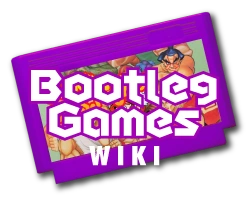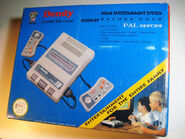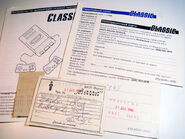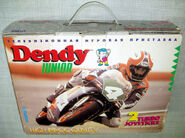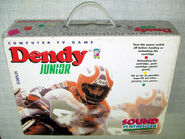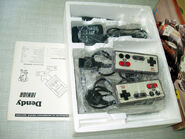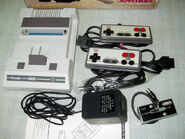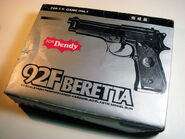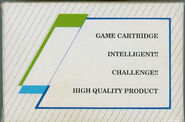mNo edit summary |
|||
| (36 intermediate revisions by 20 users not shown) | |||
| Line 1: | Line 1: | ||
{{Infobox company |
{{Infobox company |
||
| + | |name = Steepler Ltd. |
||
| ⚫ | |||
| + | |image = File:SteeplerGC.png |
||
| ⚫ | |||
| + | |caption = Steepler Graphic Center's logo. |
||
| − | }}'''Steepler Ltd.''' (also refered to as 'Dendy Company') is one of the unlicensed game distributors founded in 1992 by Andrew Cheglakov. It's being infamous for their own Dendy Classic and Dendy Junior famiclones as well as their extensive advertisement campaign which includes Video-Ace (Video-Uss) Dendy magazine and Dendy: The New Reality TV show. Having a large shop network all over the former USSR, they collapsed somewhere about the 32-bit era in the year 1996. |
||
| ⚫ | |||
| ⚫ | |||
| ⚫ | |||
| − | ===1992: The beginning=== |
||
| + | |consoles = [[Dendy Classic]], [[Dendy Junior]], imported official and unofficial consoles |
||
| − | Before Dendy came into existence, gaming in the former USSR was sparse. The most widespread 'species' available prior to that point were LD handhelds like Elektronika's clones of Game & Watch or Chinese Brick Boy units. Less popular consoles were the ZX Spectrum and its clones, with the list ending with imported items such as Atari consoles or Chinese famiclones. |
||
| + | |connected = TXC Corp., [[Subor]] |
||
| − | [[File:Dendy_Logo.gif|thumb|Dendy's logo and Dendy the Elephant, Steepler's mascot, himself]] |
||
| + | |aliases = The Dendy Company (informal) |
||
| − | December of 1992 is known for the start of Dendy (which became Dendy Classic in 1993). A brand shop on Petrovka Street in Moscow was opened, where Dendies were sold for $94 each alongside their cartridges and peripherals. The lack of money at the system's inception was mostly compensated for by the TV advertisement featuring the infamous phrase "''Денди, Денди, мы все любим Денди! Денди - играют все!''" ('Dendy, Dendy, we all love Dendy! Dendy - everyone's in the game!'- this catchphrase eventually hit the intro of The New Reality show). Along with that, December seemed to be a good time for New Year presents, and the Dendy console became the best option for parents who rushed to find New Year presents for their kids. |
||
| + | }}'''Steepler Ltd.''' was a Moscow IT company founded in late 1990, mainly known for distributing the [[Micro Genius]] console series in Russia, alongside a slew of unlicensed Famicom cartridges, under the Dendy brand. Steepler's appearance on the video game market of the former USSR was accompanied by a rather large advertisement campaign that featured TV and press coverage, including the ''[[Dendy: The New Reality]]'' weekly show and the [[Video-Uss Dendy|Video-Uss Dendy magazine]]. Despite shutting their doors in 1996, they've singlehandedly managed to eliminate the technological gap between Russia and first-world countries, and their impact on the local IT industry was so huge that some of the company's spin-offs still operate to this day. |
||
| ⚫ | |||
| − | ===1993: Expansion in the elephant family=== |
||
| + | === 1991: Establishment A.K.A. Subor === |
||
| − | The end of this year (possibly November) introduced Video-Ace Dendy (pronounced Video Uss) magazine. |
||
| + | [[File:Marussia-Cheglakov.jpeg|left|thumb|300x300px|Andrey Cheglakov in 2013.]] |
||
| + | Steepler Ltd. was founded in between December 1990 and January 1991 by a few Moscow State University alumni: Andrey Cheglakov, Maxim Selivanov, Vladislav Undeyev and Rustem Ahiyarov, joined by Michael Riner who invested over $2,000,000 into the company. A few other people have worked in the company since shortly after its' foundation, including Andrey Andreev, Viktor Savyuk and Maxim Kononenko. |
||
| + | At the time, Steepler was supplying electronics and developing all kinds of IT projects for regional businesses, like computerized banking systems, or translating Windows 3.1 to Russian. Moreover, they were Hewlett-Packard's sole official distributor in the country, and most of Steepler's automated systems were in fact based on HP's hardware. |
||
| ⚫ | |||
| − | After the reorganization, Steepler makes a spinoff company out of the selling network - Lamport. By the middle of this year, 100 000-125 000 consoles were sold each month (by this time, their approximate cost was $30-35). The end of this year brings the new Taiwanese rivals, Kenga and Bitman, to the company and is also known for introducing [[Dendy: The New Reality]] show. |
||
| − | ===1995: Suponev introduces GameBoy, Video-Ace introduces Great Dragon=== |
||
| − | This year becomes disasterous for Steepler. Aside from doing good in the beginning of this year, Steepler eventually started to collapse. |
||
| + | Steepler's business has already kept growing further, to the point where they had to create several spin-off companies, which includes Steepler Graphic Center (2D and 3D graphics and modelling; also notable for selling their spreadsheet program, Spider, to Corel at one point) and Steepler Trade (office equipment vendor, would eventually become a company of its' own, as Lamport). |
||
| − | ===1996: Eventual collapse=== |
||
| − | Not exactly known what led Steepler to bankruptcy. Rumor has it that the contract with Nintendo was the reason due to the licensed cartridges and consoles not being sold because of their price being higher than the price of pirated ones. Another reason is that it was slowly 'overran' by the Kenga and Bitman brands, 'proudly presented' by Lamport. |
||
| + | === 1992: IT expansion, the beginnings of Dendy === |
||
| ⚫ | |||
| + | For nearly a decade, the video game industry outside of former Soviet Union was thriving, but what was happening on the inside was rather limited: the arcade machines from several years ago were slowly wearing out, while most households possessed either a Game & Watch clone from Elektronika, or one among many ZX Spectrum clones, along with a tape deck. Those who were more fortunate had a clone of Atari 2600 with a few built-in games, an unbranded Chinese famiclone or, in rare cases, a proper IBM-compatible computer. |
||
| − | ===Dendy Classic and Dendy Junior=== |
||
| − | Probably, their most infamous products are still Dendy Classic and Dendy Junior famiclones. According to the 'Kommersant' newspaper's legacy articles, they were manufactured by a Taiwanese company (the title of which is promised to not to be mentioned in the article, later on, it turns out to be [http://en.wikipedia.org/wiki/Acer_Inc. Acer]) but the actual manufacturer of them is believed to be Tenzor factory in Russia. Aside from being widely advertised, the factor that influenced their high popularity was relatively cheap price and high reliabilty as well as guarantee, which is usually not presented in case with Chinese famiclones. Even to these days, Dendies are proved to be a 'bulletproof' hardware compared to the newer famiclones like Magistr (sold by [[New Game (Company)|New Game]]). |
||
| + | Steepler's computer business was in full bloom, as their financial turnover was above $15,000,000. |
||
| − | The Dendy Classic 1 and 2 are based on the [[Micro Genius]] IQ-501 and IQ-502 respectively. Early versions of the Dendy Junior also have Micro Genius and TXC logos in certain places but don't appear to correspond to any known Micro Genius model. |
||
| + | By the end of the year, the company stroke a deal with TXC to sell their Famicom hardware clones, called Micro Genius, under Steepler's own newly-established brand, Dendy. It was decided that, after the $1,000,000 investment, Micro Genius and TXC's names should not be disclosed in relation to this contract. |
||
| − | All the cartridges actually came from China, however, instead of being sold directly in the stores, they got Dendy brand back stickers and carton box inside which they were wrapped (with 'TV GAME CARTRIDGE FOR DENDY' on the front). |
||
| + | The brand's mascot, appropriately called Dendy the Elephant, was designed by Ivan Maximov, an animator and director, known by this point for his surreal short animated film, Provinicial School. Supposedly, he also animated Dendy for the brand's first commercial video. |
||
| − | Aside from wide range of cartridges, Steepler presented a lot of extra peripherals for Dendy like Beretta Gapdone lightgun or OWL Pad. |
||
| + | Around December, Steepler also launched a set of TV commercials to build hype for Dendy's initial release, which were rolling for at least a month. Then the commercials began to list Steepler's hotline number, culminating in an overwhelming number of calls from all over Russia. |
||
| − | ===PRO 16-Bit=== |
||
| − | Little known about this console, perhaps it's meant to be a hardware clone of SEGA MegaDrive II that actually has been sold along with the actual imported MDII yet had cheaper price. |
||
| − | ===SEGA MegaDrive II=== |
||
| − | This is nothing else than the actual SEGA MegaDrive II imported from Japan. However, it's not truly know if there were imported cartridges or not, however it's clear that not all the games were delivered from SEGA. |
||
| ⚫ | |||
| − | In some episodes of The New Reality, Suponev shows a Mega Key cartridge which is actually a tool that helps to override region lock. |
||
| + | [[File:SteeplerLogoOnDendy.jpg|thumb|220px|Steepler Ltd.'s logo in 1993, as seen on Dendy Classic.]] |
||
| ⚫ | |||
| + | The advertisement campaign was expanded further, with the introduction of the Dendy magazine, as made by the Video-Uss (roughly translated as "Video Ace") publishing house. Since 1990, Video-Uss has been printing a series of magazines dedicated to film - as well as one for computer games - and the house's owner, Vladimir Borev, already had contacts with Hachette Filipacchi Presse, based in France. As Video-Uss didn't have much experience in writing about video games, some of the early material was initially translated from HFP's two publications, Joypad and Joystick, while the original articles leaned more towards movies than they did to games. |
||
| − | Steepler is known to have a deal with Nintendo to 'build the bridge' that will bring SNES consoles, cartridges and accesoiries to the former USSR in 1994. Dendy: The New Reality probably played a primary role in advertising SNES among children despite having really high prices. |
||
| − | ===Handhelds (Game Boy and Virtual Boy)=== |
||
| ⚫ | |||
| − | Probably the most expensive console in Steepler's stocks. After Steepler's fall, however, it became obsolete due to the fact much cheaper SONY PlayStation was popular all over the world and that PlayStation imports has started. |
||
| + | In the span of one year, Dendy has gone from a single brand store on Krasnaya Presnya Street in Moscow to 350 stores all across the Commonwealth of Independent States, only 35 of which were fully authorized and provided all needed warranty support. |
||
| − | Panasonic 3DO was given as a first prize on Killer Instinct tournament, sponsored by Steepler. |
||
| + | The company has started talks with Nissho Iwai who wanted to choose Steepler as a distributor of Sega in former USSR countries. Unfortunately, the conversations were unsuccessful. |
||
| − | ==In the other media== |
||
| ⚫ | |||
| − | : ''Main article: [[Video-Uss Dendy and Korona]]'' |
||
| + | Steepler's financial turnover at this point in time was $40,000,000. |
||
| − | Shortly after Steepler established its' business, ''Video-Uss'' (''Видео-Асс'', lit. ''Video-Ace'') publishing agreed to start producing a new magazine in their series, subtitled as Dendy. Having approximately 20 issues in the overall showcase, the magazine had to split onto two separate branches: [[Great Dragon]] and The New Reality, the second of which lasted only four issues. |
||
| − | ===Dendy: The New Reality=== |
+ | === 1994: Dendy: The New Reality, partnership with Nintendo === |
| + | After keeping a deal with Micro Genius for many months, Steepler decided they should move all the manufacturing to Russia to save costs, which resulted in them purchasing the Tenzor instrument engineering plant, located in the city of Dubna. Along with that, after Steepler completely reorganized their assets, their retailer network, Steepler Trade, was reformed into a completely new company, Lamport. |
||
| ⚫ | |||
| + | Steepler expanded its range with Sega products. Some came from an official source and some were clones or consoles imported from other countries, such as Japan. Mega Drive sold very well and the company sold around 4,000 consoles per month. |
||
| − | Dendy: The New Reality is, perhaps, the most popular and noticeable advertising created by Steepler. With 33 episodes broadcasted on 2X2 channel and 22 on ORT, the show collapsed due to the [[Sergei Suponev]]'s (the host of the show) contract issues. |
||
| + | Since September, Sorec-Video, sponsored by Steepler, started producing Dendy: The New Reality, a half-an-hour weekly TV show hosted by the late Sergei Suponev. The show's first season has been broadcasted on 2X2 channel for approximately a year, taking 33 episodes total. |
||
| ⚫ | |||
| + | In August, Incombank and Steepler set up a new company called Dendy. |
||
| − | After Dendy: The New Reality was closed, Steepler decided to make up a new one, ''Mir Dendy'', which became a pass-by show in the result. In the era of ''Mir Dendy'', the show was hosted by Semyon Furman (in turn, an infamous actor of Russian theater and cinema) and Andrey Gvozdyov. Suponev, however, made an appearance once during this show, as a host of Killer Instinct tournament's finals. |
||
| ⚫ | |||
| − | Steepler is known to sponsor the first episodes of Ott Vinta! (lit. ''Taking Off!'') computer game reviwing show hosted by Anton Zaicev as Gameover and Boris Repetur as Bonus. The show, however, lived longer than Steepler did. |
||
| ⚫ | |||
| − | A 17-minute short cartoon made by Argus International, ''Приключения Слонёнка Dendy'' (mistranslated as Adventures of Elephant Dendy, keeping the Russian word order). The plot of the cartoon is pretty generic: The Boss, who terrorizes the peaceful city where Dendy's corporation is prospering, decides to get Dendy out of his way. Meanwhile, the little elephant prepares for a world tour with a purpose to 'make everyone in the world play Dendy'. On his trip, he brings a suitcase with all his things packed. The Boss's henchmen are up to replace this suitcase with the bomb one, but eventually confuse both of them and take the wrong one. The henchmen also attempted to replace a bottle of champagne with poison, but, obviously enough, they failed yet again. In the end, Dendy and his newly hired Secretary go on a trip without any accidents while Boss's headquarters collapse in an explosion made by the bomb suitcase. |
||
| + | In November, Steepler signed a contract with Nintendo, according to which the company became a representative of Nintendo in all countries of the former USSR. In Russia and CIS countries, Dendy was chosen as an exclusive distributor. Dendy was also supposed to have limits on sales of Sega consoles, while Steepler could sell them as much as wants. |
||
| − | Frankly enough, Dendy is the only character in the cartoon to be called by name. Also, despite this cartoon has a purpose similar to a motion picture, The Wizard, the plot is more elusive and 'cliffhangerish' than The Wizard's. |
||
| + | The delivery of Super Nintendo and Game Boy to Russia from Germany began. |
||
| − | Interestingly, Dendy's grandgrandfather drawn on the picture is shown in this cartoon. |
||
| + | === 1995: More TV shows, the magazine split === |
||
| − | ===Advertisement=== |
||
| + | Dendy signs another exclusivity deal, this time with Subor, which grants the former the rights to distribute latter's 8-bit consoles all across the Commonwealth of Independent States. |
||
| − | Steepler is known to advertise their products on television. Some of their ads are known to be shown during the broadcast of Dendy: The New Reality show. |
||
| + | Dendy: The New Reality's initial run has ended, as the show moved to ORT, with its' production handed over to Klass!, for the second season. After the overwhelming success of the last year's Dendy: The New Reality, Sergei Suponev returns as both the host and scriptwriter. |
||
| − | ==Trivia== |
||
| − | *[http://en.wikipedia.org/wiki/Ivan_Maximov Ivan Maximov] was in charge of designing Dendy the Elephant, Steepler's probably most infamous trademark. |
||
| + | Steepler decided to fund another TV show, probably because of how they didn't quite leave the PC market yet, and because of how popular Dendy: The New Reality turned out to be. Ott Vinta! (lit. "Taking Off!", "vint" can also be used as a slang word for a hard disk drive) was hosted by Anton Zaicev and Boris Repetur, playing the roles of Gameover and Bonus respectively. Despite the show's cult classic status, it went through a slew of financial, networking and creative difficulties post-Steepler, before going into hiatus in 1998 and resurfacing in 2014. |
||
| ⚫ | |||
| + | The magazine funds, on the other hand, were severely cut, which resulted in Video-Uss Dendy to be split into two different magazines. The New one called Dendy: The New Reality just like TV show have only few issue, supposedly because of its' unreadable and near-psychedelic approach to page design. The other branch, titled [[Great Dragon|Velikiy Drakon]] (also referred to as Great Dragon), remained operational up until 2003. |
||
| − | <gallery widths="120" captionalign="left"> |
||
| + | |||
| ⚫ | |||
| + | === 1996: Mir Dendy, animated short, eventual decline === |
||
| ⚫ | |||
| + | After a while, the second season of Dendy: The New Reality turned into a weekly clip show, until it went off air completely, due to Suponev having contractual obligations with NTV. Because of that, Steepler gave the concept of a TV show about games another try, with Mir Dendy (The World of Dendy), hosted by Semyon Furman, a prolific theatre and film actor, and a much younger Anton Gvozdyov. After Suponev's very successful run as a host, the critical reception to Mir Dendy wasn't very positive. Suponev, however, was reinvited to the show once, to host the finals of the Steepler-funded Killer Instinct tournament. Nevertheless, the ratings for the show were really low, hence why Mir Dendy was pulled off the TV after only a few episodes. |
||
| + | |||
| + | A twelve-minute animated short titled "[https://www.youtube.com/watch?v=cMg9QOdmzkc Adventures of Elephant Dendy]" (Приключения слоненка Dendy) was produced by Argus International in 1996, under license from Steepler. The cartoon is about Dendy the Elephant fighting against criminal rats attacking the city. It is unknown where the short aired or how it was originally distributed. |
||
| + | |||
| + | Steepler Ltd. ceased all production of its' own this year, for no officially disclosed reason. The most reasonable explanation to what really happened, however, was provided by Forbes Magazine in 2004: after Steepler announced they got carte blanche to automate the Russian State Duma, they were threatened by the Federal Agency of Government Communications and Information. Said threat was followed by several key members of the company being heavily injured, complete with one of them being ran over by a car. Fearing for their lives, the remains of Steepler's board of directors decided to leave the country immediately. |
||
| + | |||
| + | Despite the fall of the giant, it was not the end yet. The Dendy company itself remained, continuing its activity in the sale of consoles in former USSR countries. The assortment has been extended with such consoles as Sega Saturn. Dendy has also become an authorized Sony PlayStation dealer. At the end of the year, Mir Dendy's new season was created. |
||
| + | ===1997-1998 Fate of Dendy === |
||
| + | The company did not perform well. In stores, in small quantities, Game Boy Pocket and Nintendo 64 appeared, but they did not gain much popularity. The last big undertaking was Bonza, a gambling game released by Dendy on Sega Mega Drive, Dendy and small special portable consoles. In 1998, the company collapsed due to the financial crisis in Russia. |
||
| + | |||
| + | == Key people == |
||
| + | |||
| + | == Legacy == |
||
| + | A surprising amount of Steepler's spin-off companies (or entities initially funded by them or lead by its' former employees) continue to operate today, with Steepler Graphic Center being the only one to be named after its' parent. |
||
| + | |||
| ⚫ | |||
| + | |||
| + | ===Dendy series=== |
||
| + | *Dendy Classic |
||
| + | *Dendy Junior |
||
| + | |||
| + | ===Nintendo=== |
||
| ⚫ | |||
| + | *Game Boy |
||
| + | *Game Boy Pocket |
||
| + | *Nintendo 64- |
||
| + | *The Virtual Boy was planned to be released by Steepler, but was canceled, as was all European distribution for the platform (due to its massive failure in other regions). However, the imported version could be purchased for a special order. |
||
| + | *Nintendo Entertainment System (NES)- Steepler also possessed the rights for the original NES, but chose not to release it due to being effectively identical to the Dendy. |
||
| + | |||
| + | ===Others=== |
||
| + | *Subor |
||
| + | *PRO 16-Bit (bootleg Sega Genesis clone) |
||
| + | *Sega Mega Drive II |
||
| ⚫ | |||
| + | *Sega Genesis CDX |
||
| + | *Bonza |
||
| + | *Sega Saturn |
||
| + | *PlayStation |
||
| + | |||
| + | == Media == |
||
| + | |||
| + | === Video-Uss Dendy magazine === |
||
| + | |||
| ⚫ | |||
| + | |||
| ⚫ | |||
| + | |||
| ⚫ | |||
| + | |||
| ⚫ | |||
| + | |||
| ⚫ | |||
| + | |||
| ⚫ | |||
| + | <gallery> |
||
| + | Dendy Logo.gif|Dendy's logo. |
||
| ⚫ | |||
| ⚫ | |||
classic3.jpg|Dendy Classic's manual, warranty card, registration card and cash cheque. Shot by Valera Kibiks. |
classic3.jpg|Dendy Classic's manual, warranty card, registration card and cash cheque. Shot by Valera Kibiks. |
||
| − | junior_1.jpg|Dendy Junior's box (with Steepler's logo on it). |
+ | junior_1.jpg|Dendy Junior's box (with Steepler's logo on it). Photo by andrey228. |
| − | junior_2.jpg|Dendy Junior's box (rear side). |
+ | junior_2.jpg|Dendy Junior's box (rear side). Photo by andrey228. |
| − | junior_3.jpg|Dendy Junior's peripherals and manual. |
+ | junior_3.jpg|Dendy Junior's peripherals and manual. Photo by andrey228. |
| − | junior_5.jpg|Dendy Junior console, gamepads, AC adapter and RC transmitter (in case if the TV set had no video/audio inputs, |
+ | junior_5.jpg|Dendy Junior console, gamepads, AC adapter and RC transmitter (in case if the TV set had no video/audio inputs, like most old Soviet TV sets). Photo by andrey228. |
| − | Dendyjuniorjoypad.jpg|An early Dendy Junior joypad. |
+ | Dendyjuniorjoypad.jpg|An early Dendy Junior joypad. Photo by Sputnikmisha90. |
| − | beretta.jpg|Beretta lightgun's box. |
+ | beretta.jpg|Beretta lightgun's box. Photo by Valera Kibiks. |
| − | beretta2.jpg|Beretta lightgun in a package. |
+ | beretta2.jpg|Beretta lightgun in a package. Photo by Valera Kibiks. |
| − | box2.jpg|Steepler's early design of cartridges' package boxes. These always had holes to show the sticker of the cartridge itself (in this case, TMNT Tournament Fighters). |
+ | box2.jpg|Steepler's early design of cartridges' package boxes. These always had holes to show the sticker of the cartridge itself (in this case, TMNT Tournament Fighters). Photo by clockwork. |
| − | box2a.jpg|Steepler's early design of cartridges' package boxes. Rear view. |
+ | box2a.jpg|Steepler's early design of cartridges' package boxes. Rear view. Photo by clockwork. |
</gallery> |
</gallery> |
||
| + | |||
| + | {{Companies}} |
||
| + | [[ru: Steepler Ltd.]] |
||
| ⚫ | |||
[[Category:Publishers]] |
[[Category:Publishers]] |
||
[[Category:Steepler Ltd.]] |
[[Category:Steepler Ltd.]] |
||
[[Category:Dendy-related media]] |
[[Category:Dendy-related media]] |
||
| ⚫ | |||
Revision as of 10:49, 22 April 2020
Steepler Ltd. was a Moscow IT company founded in late 1990, mainly known for distributing the Micro Genius console series in Russia, alongside a slew of unlicensed Famicom cartridges, under the Dendy brand. Steepler's appearance on the video game market of the former USSR was accompanied by a rather large advertisement campaign that featured TV and press coverage, including the Dendy: The New Reality weekly show and the Video-Uss Dendy magazine. Despite shutting their doors in 1996, they've singlehandedly managed to eliminate the technological gap between Russia and first-world countries, and their impact on the local IT industry was so huge that some of the company's spin-offs still operate to this day.
History
1991: Establishment A.K.A. Subor
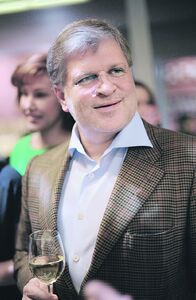
Andrey Cheglakov in 2013.
Steepler Ltd. was founded in between December 1990 and January 1991 by a few Moscow State University alumni: Andrey Cheglakov, Maxim Selivanov, Vladislav Undeyev and Rustem Ahiyarov, joined by Michael Riner who invested over $2,000,000 into the company. A few other people have worked in the company since shortly after its' foundation, including Andrey Andreev, Viktor Savyuk and Maxim Kononenko.
At the time, Steepler was supplying electronics and developing all kinds of IT projects for regional businesses, like computerized banking systems, or translating Windows 3.1 to Russian. Moreover, they were Hewlett-Packard's sole official distributor in the country, and most of Steepler's automated systems were in fact based on HP's hardware.
Steepler's business has already kept growing further, to the point where they had to create several spin-off companies, which includes Steepler Graphic Center (2D and 3D graphics and modelling; also notable for selling their spreadsheet program, Spider, to Corel at one point) and Steepler Trade (office equipment vendor, would eventually become a company of its' own, as Lamport).
1992: IT expansion, the beginnings of Dendy
For nearly a decade, the video game industry outside of former Soviet Union was thriving, but what was happening on the inside was rather limited: the arcade machines from several years ago were slowly wearing out, while most households possessed either a Game & Watch clone from Elektronika, or one among many ZX Spectrum clones, along with a tape deck. Those who were more fortunate had a clone of Atari 2600 with a few built-in games, an unbranded Chinese famiclone or, in rare cases, a proper IBM-compatible computer.
Steepler's computer business was in full bloom, as their financial turnover was above $15,000,000.
By the end of the year, the company stroke a deal with TXC to sell their Famicom hardware clones, called Micro Genius, under Steepler's own newly-established brand, Dendy. It was decided that, after the $1,000,000 investment, Micro Genius and TXC's names should not be disclosed in relation to this contract.
The brand's mascot, appropriately called Dendy the Elephant, was designed by Ivan Maximov, an animator and director, known by this point for his surreal short animated film, Provinicial School. Supposedly, he also animated Dendy for the brand's first commercial video.
Around December, Steepler also launched a set of TV commercials to build hype for Dendy's initial release, which were rolling for at least a month. Then the commercials began to list Steepler's hotline number, culminating in an overwhelming number of calls from all over Russia.
1993: The Dendy magazine, fame and fortune

Steepler Ltd.'s logo in 1993, as seen on Dendy Classic.
The advertisement campaign was expanded further, with the introduction of the Dendy magazine, as made by the Video-Uss (roughly translated as "Video Ace") publishing house. Since 1990, Video-Uss has been printing a series of magazines dedicated to film - as well as one for computer games - and the house's owner, Vladimir Borev, already had contacts with Hachette Filipacchi Presse, based in France. As Video-Uss didn't have much experience in writing about video games, some of the early material was initially translated from HFP's two publications, Joypad and Joystick, while the original articles leaned more towards movies than they did to games.
In the span of one year, Dendy has gone from a single brand store on Krasnaya Presnya Street in Moscow to 350 stores all across the Commonwealth of Independent States, only 35 of which were fully authorized and provided all needed warranty support.
The company has started talks with Nissho Iwai who wanted to choose Steepler as a distributor of Sega in former USSR countries. Unfortunately, the conversations were unsuccessful.
Steepler's financial turnover at this point in time was $40,000,000.
1994: Dendy: The New Reality, partnership with Nintendo
After keeping a deal with Micro Genius for many months, Steepler decided they should move all the manufacturing to Russia to save costs, which resulted in them purchasing the Tenzor instrument engineering plant, located in the city of Dubna. Along with that, after Steepler completely reorganized their assets, their retailer network, Steepler Trade, was reformed into a completely new company, Lamport.
Steepler expanded its range with Sega products. Some came from an official source and some were clones or consoles imported from other countries, such as Japan. Mega Drive sold very well and the company sold around 4,000 consoles per month.
Since September, Sorec-Video, sponsored by Steepler, started producing Dendy: The New Reality, a half-an-hour weekly TV show hosted by the late Sergei Suponev. The show's first season has been broadcasted on 2X2 channel for approximately a year, taking 33 episodes total.
In August, Incombank and Steepler set up a new company called Dendy.
In November, Steepler signed a contract with Nintendo, according to which the company became a representative of Nintendo in all countries of the former USSR. In Russia and CIS countries, Dendy was chosen as an exclusive distributor. Dendy was also supposed to have limits on sales of Sega consoles, while Steepler could sell them as much as wants.
The delivery of Super Nintendo and Game Boy to Russia from Germany began.
1995: More TV shows, the magazine split
Dendy signs another exclusivity deal, this time with Subor, which grants the former the rights to distribute latter's 8-bit consoles all across the Commonwealth of Independent States.
Dendy: The New Reality's initial run has ended, as the show moved to ORT, with its' production handed over to Klass!, for the second season. After the overwhelming success of the last year's Dendy: The New Reality, Sergei Suponev returns as both the host and scriptwriter.
Steepler decided to fund another TV show, probably because of how they didn't quite leave the PC market yet, and because of how popular Dendy: The New Reality turned out to be. Ott Vinta! (lit. "Taking Off!", "vint" can also be used as a slang word for a hard disk drive) was hosted by Anton Zaicev and Boris Repetur, playing the roles of Gameover and Bonus respectively. Despite the show's cult classic status, it went through a slew of financial, networking and creative difficulties post-Steepler, before going into hiatus in 1998 and resurfacing in 2014.
The magazine funds, on the other hand, were severely cut, which resulted in Video-Uss Dendy to be split into two different magazines. The New one called Dendy: The New Reality just like TV show have only few issue, supposedly because of its' unreadable and near-psychedelic approach to page design. The other branch, titled Velikiy Drakon (also referred to as Great Dragon), remained operational up until 2003.
1996: Mir Dendy, animated short, eventual decline
After a while, the second season of Dendy: The New Reality turned into a weekly clip show, until it went off air completely, due to Suponev having contractual obligations with NTV. Because of that, Steepler gave the concept of a TV show about games another try, with Mir Dendy (The World of Dendy), hosted by Semyon Furman, a prolific theatre and film actor, and a much younger Anton Gvozdyov. After Suponev's very successful run as a host, the critical reception to Mir Dendy wasn't very positive. Suponev, however, was reinvited to the show once, to host the finals of the Steepler-funded Killer Instinct tournament. Nevertheless, the ratings for the show were really low, hence why Mir Dendy was pulled off the TV after only a few episodes.
A twelve-minute animated short titled "Adventures of Elephant Dendy" (Приключения слоненка Dendy) was produced by Argus International in 1996, under license from Steepler. The cartoon is about Dendy the Elephant fighting against criminal rats attacking the city. It is unknown where the short aired or how it was originally distributed.
Steepler Ltd. ceased all production of its' own this year, for no officially disclosed reason. The most reasonable explanation to what really happened, however, was provided by Forbes Magazine in 2004: after Steepler announced they got carte blanche to automate the Russian State Duma, they were threatened by the Federal Agency of Government Communications and Information. Said threat was followed by several key members of the company being heavily injured, complete with one of them being ran over by a car. Fearing for their lives, the remains of Steepler's board of directors decided to leave the country immediately.
Despite the fall of the giant, it was not the end yet. The Dendy company itself remained, continuing its activity in the sale of consoles in former USSR countries. The assortment has been extended with such consoles as Sega Saturn. Dendy has also become an authorized Sony PlayStation dealer. At the end of the year, Mir Dendy's new season was created.
1997-1998 Fate of Dendy
The company did not perform well. In stores, in small quantities, Game Boy Pocket and Nintendo 64 appeared, but they did not gain much popularity. The last big undertaking was Bonza, a gambling game released by Dendy on Sega Mega Drive, Dendy and small special portable consoles. In 1998, the company collapsed due to the financial crisis in Russia.
Key people
Legacy
A surprising amount of Steepler's spin-off companies (or entities initially funded by them or lead by its' former employees) continue to operate today, with Steepler Graphic Center being the only one to be named after its' parent.
Products sold
Dendy series
- Dendy Classic
- Dendy Junior
Nintendo
- Super Nintendo Entertainment System (SNES)
- Game Boy
- Game Boy Pocket
- Nintendo 64-
- The Virtual Boy was planned to be released by Steepler, but was canceled, as was all European distribution for the platform (due to its massive failure in other regions). However, the imported version could be purchased for a special order.
- Nintendo Entertainment System (NES)- Steepler also possessed the rights for the original NES, but chose not to release it due to being effectively identical to the Dendy.
Others
- Subor
- PRO 16-Bit (bootleg Sega Genesis clone)
- Sega Mega Drive II
- Panasonic 3DO
- Sega Genesis CDX
- Bonza
- Sega Saturn
- PlayStation
Media
Video-Uss Dendy magazine
Dendy: The New Reality
- Main article: Dendy: The New Reality
